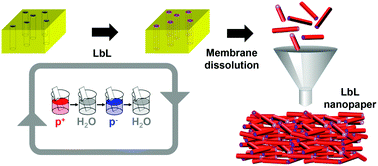Nanopapers of layer-by-layer nanotubes
Abstract
Mats of nanofibers are important as biological scaffolds, (bio)functional electrodes, or smart membranes. Herein, we show that layer-by-layer (LbL) assembly of a wide variety of compounds in nanoporous templates, followed by a straightforward filtration methodology of the nanotubes after membrane dissolution, leads to the fabrication of LbL nanopapers over centimeter square surfaces. The texture of the nanopapers can be easily tuned by varying the rigidity of the nanofibers, which can be achieved by changing their wall thickness, crosslinking them, or developing nanotubes with a core–shell structure. In the nanopapers, the tubes deform by different mechanisms, including flattening, twisting and scrolling, depending on tube rigidity. The possibility to manufacture multilayered nanopapers made of stacks of different nanofibers, or chemically post-functionalize them, is also demonstrated; in addition, the fabrication of enzymatically-active nanopapers is shown. Considering the vast range of materials which can be used for the construction of nanotubes including, e.g., proteins, polysaccharides, conducting polymers or nanoparticles, and the many possible post-functionalization techniques of LbL films, the methodology offers a very flexible route to a virtually limitless collection of functional smart nanopapers.



 Please wait while we load your content...
Please wait while we load your content...